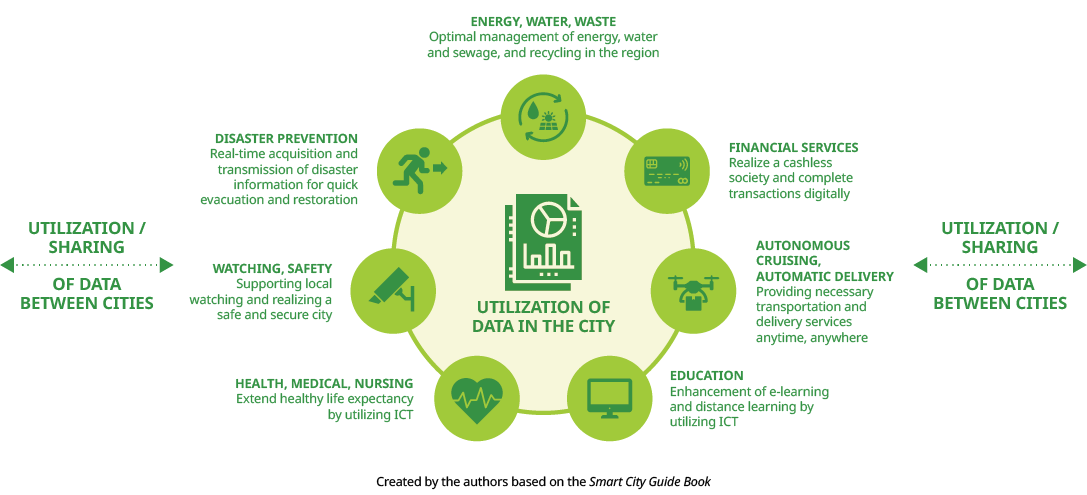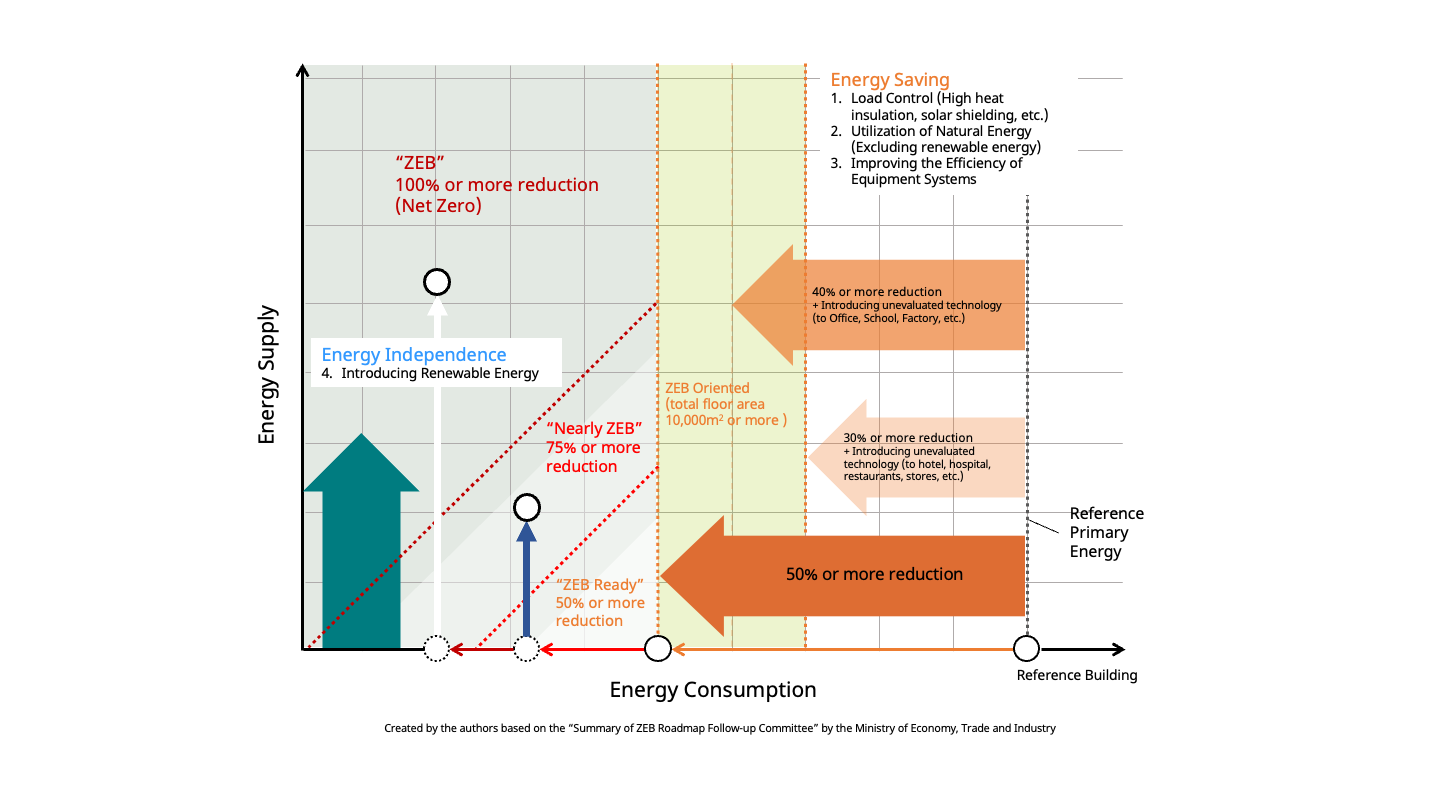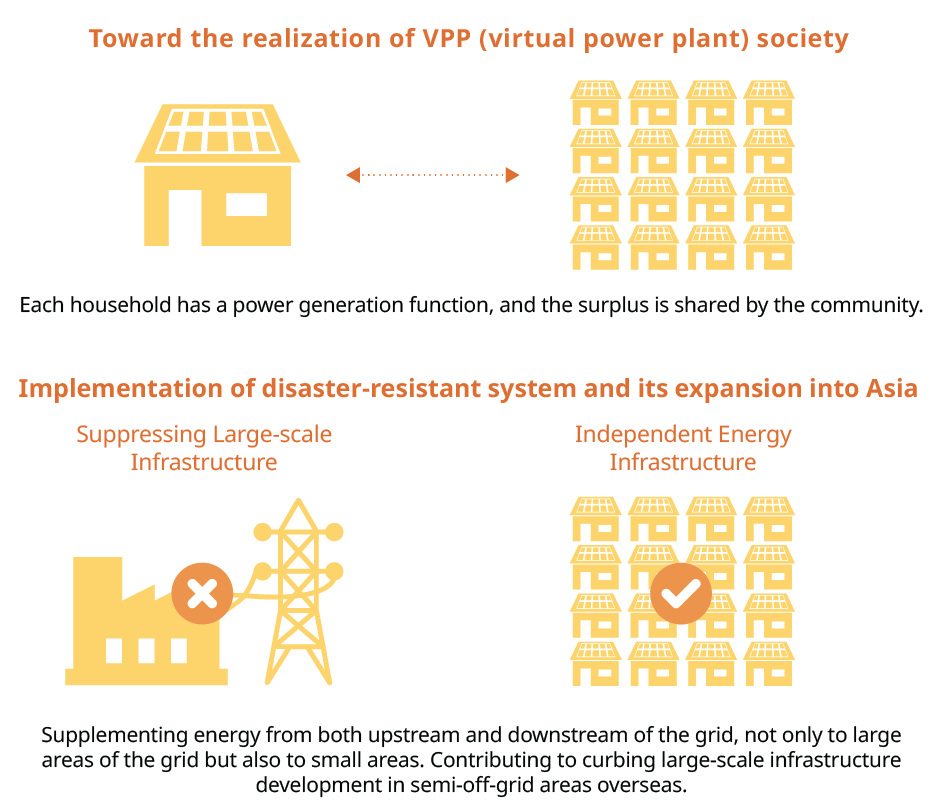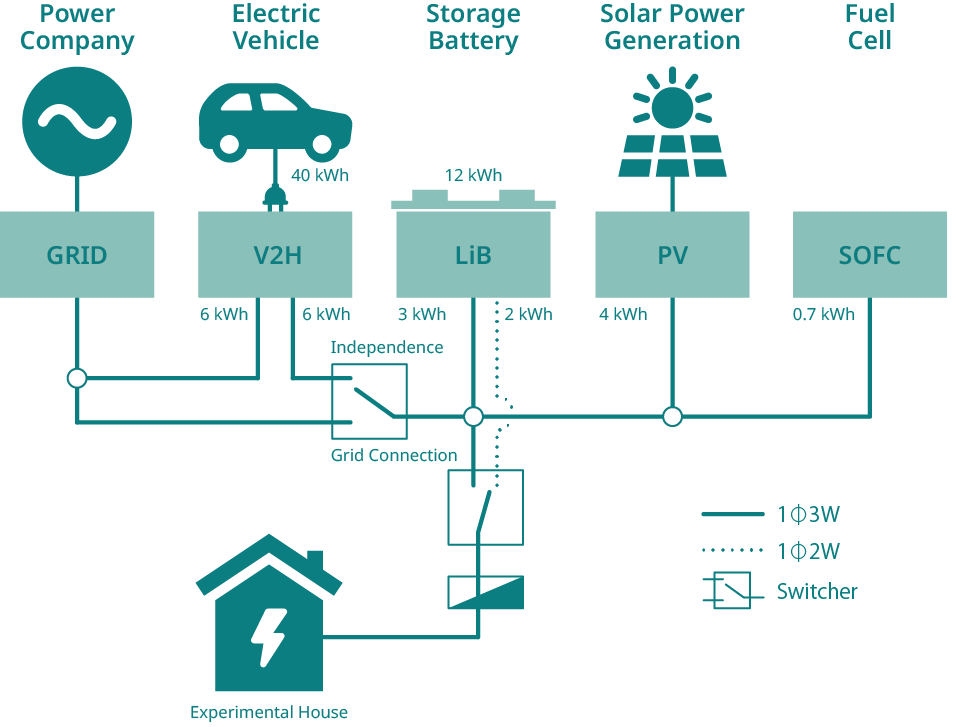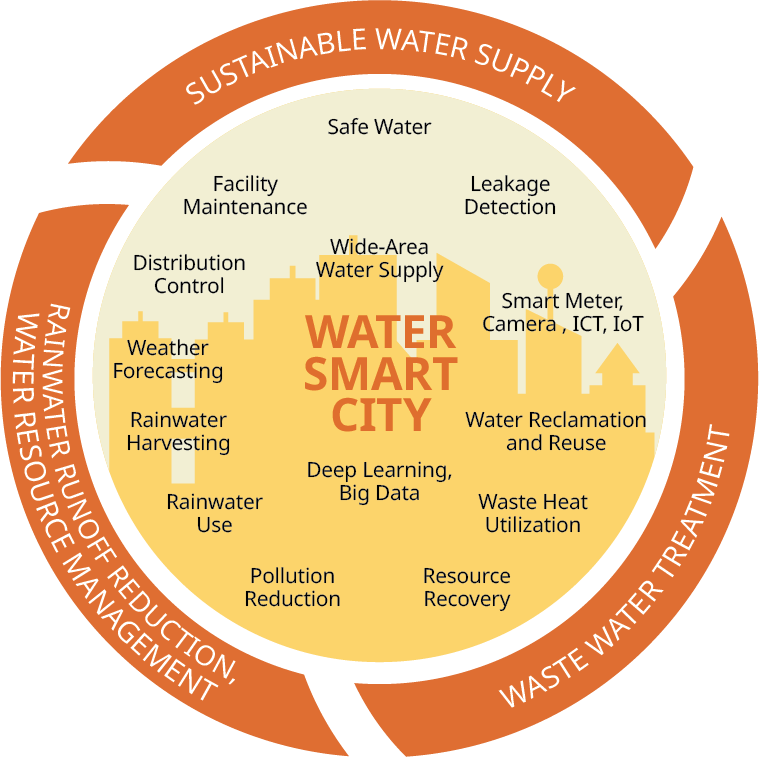3. Smart City
- Tomoyuki Chikamoto, Professor, College of Science and Engineering Department of Architecture and Urban Design, Ritsumeikan University (Japan)
- Toshiyuki Shimizu, Associate Professor, Faculty of Urban Management, Fukuyama City University (Japan)
What is a “Smart City”?
Definitions and Trends of Smart Cities in the World
The Organization for Economic Co-operation and Development () defines “Smart Cities” as “initiatives or approaches that effectively leverage digitalization to boost citizen’s well-being and deliver more efficient, sustainable and inclusive urban services and environments as part of a collaborative, multi-stakeholder process” (). However, it also states, “the smart city concept is still in flux and subject to debate. Definitions of smart cities vary across OECD countries and institutions according to the geopolitical context and to the specific issues at hand”().
In terms of global trends on smart cities, the G20 Global Smart Cities Alliance was established in 2019 with the World Economic Forum as its secretariat (; ). The alliance aims to develop international basic principles and guidelines for cities to use data and digital technologies. Thirty-six cities from around the world are participating as pioneer cities, and four cities from Japan are participating: Maebashi, Kaga, Hamamatsu, and Kakogawa (Fig. 3.1).
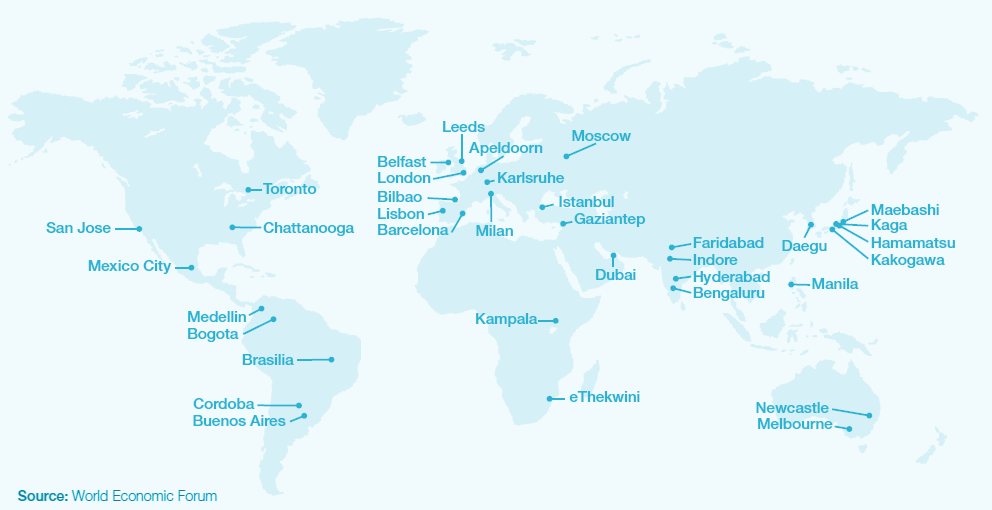
There is also a report of survey results available on the benchmarking of building policies for ethical and responsible governance in smart city development. The standards used for benchmarking include “equity, inclusivity and social impact,” “privacy and transparency,” “security and resilience,” “operational and financial sustainability,” and “openness and interoperability,” and the results of a survey of 36 pioneer cities are presented.
Definitions and Trends among Smart Cities in Japan
According to the Smart City Guidebook () published by the Cabinet Office of Japan’s Ministry of Internal Affairs and Communications, the Ministry of Economy, Trade, and Industry (METI), and the Ministry of Land, Infrastructure, Transport, and Tourism (MLIT), smart cities can be defined as "sustainable cities or districts that continue to create new value by solving various problems faced by cities and districts through the provision of services that are close to each citizen, utilizing new technologies such as ICT and various types of data from the public and private sectors, and the advancement of management (planning, maintenance, management, operation, etc.) in various fields, and where Society 5.0 can be realized ahead of time." Smart cities as defined by the MLIT are classified and organized as shown in Table 3.1.
It should be noted as well that Society 5.0 is defined as "a human-centered society that achieves both economic development and solutions to social issues through a system that highly integrates cyberspace (virtual space) and physical space (real space)" () It refers to a new society following the hunting society (Society 1.0), agricultural society (Society 2.0), industrial society (Society 3.0), and information society (Society 4.0), and was first proposed as the future society that Japan should aim for in the Fifth Science and Technology Basic Plan.
As of August 2021, 184 projects are introduced on the Smart City Platform website. The main smart city-related projects promoted by the relevant ministries and agencies include: a) The Social implementation project for near-future technologies by the Cabinet Office; b) the Smart City Promotion Project for data utilization by the Ministry of Internal Affairs and Communications; c) the Regional New “MaaS” (Mobility as a Service) Creation and Promotion Project by the Ministry of Economy; Trade and Industry, d) the Project for the Promotion of New Mobility Services by the Ministry of Land, Infrastructure, Transport and Tourism (MLIT); and e) the Smart City Model Project by the MLIT (see Table 3.2). The number of projects that include transportation as an issue is 158, and 143 projects include tourism and regional revitalization, indicating that smart city initiatives in Japan are mainly focused on transportation issues (MaaS), tourism, and regional revitalization (Table 3.3).
Table 3.1: Classification of Smart Cities by the MLIT
| Category | Description |
|---|---|
| Accessibility | All citizens can move around comfortably with a focus on public transportation, improved convenience and transportation services through the use of automated driving, demand-responsive transportation, and MaaS.] |
| Nature | Urban space exists in harmony with water and greenery. |
| Energy | Realization of energy conservation at the building/block/district-level from both passive and active aspects. Utilization of renewable energy such as solar and wind power, promoting local production and consumption of energy that is secure even in emergencies. |
| Safety & Security | Developing disaster-resistant cities, fostering local communities, and securing emergency power generators, stockpiles, and evacuation sites in urban development. Remote management of health conditions using wearable terminals, promoting walking through the use of apps, monitoring rivers using water level sensors. |
| Recycle | Storage and utilization of rainwater, use of reclaimed water from wastewater treatment as non-potable water, waste management (3R, waste heat utilization, etc.). |
From Smart Cities to Super Cities
In order to realize regional development in accordance the Super City concept, the Cabinet Office has invited applications for the designation of Super City-type National Strategic Special Zones, and a number of local governments have applied for this designation. While smart cities focus on demonstrations of one or more state-of-the-art technologies such as transportation and energy, super cities are future cities that will implement information technology as a basic social infrastructure.
Smart Cities and Sustainable Development Goals (SDGs)
The SDGs are international goals to be achieved by 2030 as stated in the "2030 Agenda for Sustainable Development" adopted at the United Nations Sustainable Development Summit 2015; they consist of 17 Goals and 169 Targets ().
Goal 11 of the SDGs reads: "Make cities and human settlements inclusive, safe, resilient and sustainable," and indeed the realization of smart cities is deeply related to the achievement of Goal 11. However, the scope of the SDGs is broad, and smart cities are related to all 17 Goals, as well as to 81 targets (). The Keidanren (Japan Business Federation) also states that Society 5.0 will contribute significantly to the achievement of SDGs because it is a new growth model that combines problem solving and future innovations. Since smart cities are the places where Society 5.0 will be demonstrated, the realization and implementation of smart cities is essential to the achievement of the SDGs.
Table 3.2: Number of Projects by Project Aim
| Project Name | Number of Projects |
|---|---|
| Social implementation project for near-future technologies | 34 |
| Smart City Promotion Project for data utilization | 18 |
| Regional New MaaS Creation Promotion Project | 29 |
| The Project for the Promotion of New Mobility Services | 57 |
| The Smart City Model Project | 45 |
| MLIT Smart Island Promotion Demonstration Survey | 1 |
| Total | 184 |
Table 3.3: Number of Smart City Projects in Japan by Issue Category (Multiple Answers Permitted)
| Classification of Issues | Number of Projects |
|---|---|
| Transportation and Mobility | 158 |
| Energy | 22 |
| Disaster Prevention | 36 |
| Maintenance and Management of Infrastructure | 38 |
| Tourism and Regional Revitalization | 143 |
| Well-Being and Medical | 48 |
| Agriculture, Forestry, and Fishery | 17 |
| Environment | 17 |
| Safety, Security, and Surveillance | 21 |
| Logistics | 31 |
| Urban Planning and Development | 18 |
| Total Number of Projects | 184 |
Energy Management in the Smart City
The biggest element that constitutes a smart city is the decision to avoid sustaining life in the city through the consumption of large amounts of fossil fuel by supplying the necessary power by renewable energy while reducing energy consumption. In other words, the energy supply and demand are managed between the consumer side and the power generation side.
Zero and Net Energy Buildings
Net Zero Energy Buildings (ZEB) and Net Zero Energy Houses (ZEH) are buildings or houses that aim to reduce the annual primary energy balance consumed while maintaining a comfortable indoor environment.
Since there are human activities in the building, energy consumption cannot be completely reduced to zero. Yet the total energy consumption is reduced through energy-saving processes which, when combined with renewable energy, lead to zero energy consumption.
The definition of ZEB / ZEH has been discussed and examined in various ways both in Japan and abroad. For example, in Japan, if an energy savings of 30% or more is achieved in a building, it is “ZEB Oriented.” If an energy savings of 50% or more has been achieved and it aims to use renewable energy it is “ZEB Ready.” Furthermore, it is classified as “Nearly ZEB” when it has achieved a reduction in energy consumption of 75% or more through energy saving processes and the use of renewable energy, and is at that point considered to represent a realization and popularization of the goals of the ZEB policy.
The Importance of Regional Power Sources
Until now, power systems have relied on demand control to shift to midnight power in order to stabilize nuclear power generation (base power) and power generation has been centrally controlled by the supply of large-scale power plants built according to power demand.
However, in the wake of the tightening of supply and demand following the Great East Japan Earthquake, it became apparent that it is important not only to strengthen conventional energy conservation but also to manage energy with an awareness of the balance between supply and demand. In addition, the introduction of renewable energy sources such as solar power and wind power is progressing, but the amount of power they generate depends on natural conditions such as the weather, and even in favorable conditions the area where the power trunk line is not as thick as necessary becomes the power generation limit. Therefore, generation needs to be stabilized on a regional basis by a control method other than a central power plant control system.
In addition, decentralized energy resources, including cogeneration methods like solar power and household fuel cells, along with storage batteries, electric vehicles, and “negawatts” (power saving), have been introduced to consumers on a wide scale.
For this reason, the conventional energy supply system that relies on large-scale power plants is being revised, and the construction of a mechanism for utilizing energy resources on the consumer-side of the electric power system is being promoted. Each of the decentralized energy resources available to buildings and homes are small, but they can be used to adjust the balance between the supply and demand of electricity by remote and integrated control using advanced energy management technology that utilizes the Internet of Things (IoT). This mechanism is called a virtual power plant (VPP). VPPs are expected to play an active role in future electric power systems, offering functions such as load leveling, absorption of excess supply of renewable energy, and providing supply in the event of power shortage. Moreover, not only in Japan, but also in areas where energy infrastructure is not well-developed or unstable, VPPs will lead to stable energy use on a regional basis without requiring large-scale infrastructure.
In a self-sustaining operational experiment—using an experimental house in my own laboratory during a power outage—a 40kWh electric vehicle (EV) was connected to a 12kWh storage battery (LiB, Lithium ion storage battery), and 4kW of solar power generation (PV) was used to generate electricity. So, depending on the ratio of the amount of electricity stored to the amount of electricity used, I was able to maintain a stable life for several days.
Based on these experimental results, we are constructing an energy independence model for the region and observing how much tolerance it has under various conditions, while also assessing introduction costs along with the usual merits and drawbacks. Verification is in progress.
Safe, Secure, and Healthy Living
A major feature of smart cities is the utilization of IoT to support an aging society. This is part of the reason that the IoT, in which all things are connected to the Internet, is being promoted to maintain a healthy standard of living. Through it, various things such as smartphones, smart speakers, personal computers, home appliances, and automobiles share information on the Internet and control other devices. A "sensor" that detects the environmental state of its surroundings is indispensable for realizing the full potential of IoT . In particular, the development of the Micro Electromechanical System (MEMS), which is a micron-level device that integrates sensors, actuators, electronic circuits, etc., and is constructed of miniaturized mechanical elements, seeks to provide this.
Even in homes, offices, factories, etc., MEMS senses the ever-changing environment, and various equipment such as air conditioning and lighting are linked to create a comfortable and energy-saving environment. MEMS can be incorporated into various equipment to create a safe, secure, comfortable, and convenient experience for inhabitants.
If the sensor is made sufficiently small, it becomes possible to sense the physiological levels and conditions of a person while wearing it. In this way, the activity and health status of the person can be easily confirmed. Additionally, using this information can lead to a more comfortable and healthy life.
The wristwatch-type wearable information terminal is equipped with a heart rate monitor and GPS in addition to a three-dimensional accelerometer that measures the amount of activity and calories burned. The life log (a "visualization" of the body) is recorded both throughout the day and during sleep. It is used for health management and measures the amount and intensity of sleep. Users can also measure the balance of their caloric intake by inputting meals and weight.
Due to the movement to improve the environmental performance of buildings (see, for example, the Leadership in Energy and Environmental Design [LEED] of the US Green Building Council), interest in the health and working styles of people who spend time in buildings is changing (see also the WELL Building Standard of the International WELL Building Institute).
In my laboratory, while we acquire biometric information we are also exploring the relationship between subjective reports and physiological reactions that people feel, and we are also conducting research on working environment, working style, and productivity through Activity Based Working. I feel that human-centered design oriented toward human factors will become mainstream in the future.
Water Management in Smart Cities
Japan has about twice as much rainfall as the world average, and due to the effect of water resource development such as dams, it could be said that the frequency of drought is relatively low. On the other hand, looking at the world, it is expected that water shortages will be caused not only in areas that are physically prone to drought due to small rainfall, but also due to overuse through socioeconomic factors such as population growth and the concentration of populations in cities. In addition, the unequal spatial-temporal distribution of limited water resources in the world is worsening because of climate change. In areas where water shortages are serious, rainwater use and water reclamation/reuse are very important. It would be particularly useful in these cases to actively utilize treated wastewater or reclaimed water as non-potable water for commercial facilities and factories. In addition, by centrally managing the operation data of water purification facilities and sewage treatment facilities alongside the status of water demand using smart methods, it will be possible to operate each facility efficiently and improve the management efficiency of the entire region. This is what the smart city is aiming for from the viewpoints of water infrastructure and water operations.
In Japan, population decline has become a major issue when it comes to managing and utilizing water resources. In Japan, aging facilities related to infrastructure such as water supply and sewerage systems constructed during the high-growth period have become a serious problem, and huge costs are required for their renewal. On the other hand, in recent years, water demand has been declining due to population decline and the advancement of water-saving methods, so it is necessary to rebuild facilities with downsizing in mind. In Japan, water supply and sewage systems are managed by local governments, but wide-ranging cooperation beyond the boundaries of municipalities and, in some cases, prefectures will be required.
Wide-Area Water Supply in Smart Cities
In Japan, water utilities that provide drinking water are, in principle, managed and operated by municipalities and are required to be financially independent with full cost recovery. The business situations of the water supply utilities are expected to become more severe due to the declining population and aging facilities and pipelines. It is important to strengthen the management base, improve the efficiency of office work, and secure the technical level of their operations by promoting various wide-ranging cooperation such as utilities integration, joint facilities development, and wide-area processing in office work. Therefore, it is necessary to consider strategic widening with an eye on the future. Coordination between prefectures is important in efforts to extend the area of operations beyond the traditional administrative areas of municipalities. Therefore, the Japanese Ministry of Internal Affairs and Communications and the Ministry of Health, Labor and Welfare are requesting that prefectures formulate a promotion plan for a wide area of water supply as stipulated by both the promotion policy for wide cooperation and the content of particular efforts. Now is the time to make the best use of existing facilities and to consider water supply systems that utilize wide-area operations such as connecting pipes, common water purification facilities, and distribution reservoirs in cooperation with related business operators.
This concept of wide-area water supply incorporates a diverse range of initiatives, including the sharing of operation departments (fee collection, maintenance, water quality management, training programs, etc.). There is also a proposal aiming to unite operations within one water supply system for the entire prefecture.
On the other hand, gaps between water utilities in areas such as tariff levels, financial conditions, and facility levels are barriers to the promotion of wide-area water supply. Wide-area water supply in a broad sense includes not only utilities integration but also joint operation and joint management, and it will be necessary for stakeholders to cooperate based on what the utilities concerned can do together. In particular, material ordering and inventory management systems are relatively easy to combine, and it is expected that operating costs could be reduced by introducing and operating the same system in several regions. The introduction of the latest information technology related to water supply operation and management is also an important point. The following are possible examples: a) Improving inspection efficiency by introducing sensors into the pipeline network; b) high-quality short-term demand forecasting through machine learning, etc.; and c) prediction of raw water quality and operation/management of water purification facilities using weather forecasting.
Smart Water Meters
In recent years, the introduction of smart meters in the water supply field has attracted attention. It is expected that various improvements in the efficiency of water utilities could be achieved by installing smart meters that can offer improved efficiency in meter reading through the visualization of detailed data such as demand fluctuations, early leakage detection, improvement of user services, efficient pipeline network management, and efficient energy use through improved water operation, etc.
In addition, the improvement of user services could include monitoring for elderly people living alone, and it is possible to quickly detect abnormalities due to illness or injury of residents by monitoring the amount of water used. At present, the installation cost is a major problem, but many water utilities are conducting feasibility projects for smart meter introduction. Also, by collecting water data together with electricity and gas data, it will be possible for authorities to integrate data related to public utilities.
Sewerage in Smart Cities
Utilizing Information Technology
In Japan, the histories of water supply and sewerage systems differ slightly. Public sewerage systems were developed in each city from early on in the center of large cities, but there are many areas where prefectural governments have taken the lead in developing basin sewerage systems. Therefore, sewerage is a wide-area system compared to the water supply sector.
On the other hand, sewerage facilities are aging like water facilities. It could be possible to improve the efficiency of inspection work, prevent accidents through early repairs, and formulate a reconstruction plan by installing sensors and cameras in the sewer pipeline network and monitoring and collecting data. In addition, sewage sludge generated in the sewage treatment process has high potential as fuel and fertilizer. It is also possible to utilize sewage heat. By collaborating with water/biomass-related businesses and expanding the area of facility management, it would be possible to realize a more recycling-oriented and more energy-efficient city.
Also, one of the purposes of sewerage is to remove rainwater. In recent years, it could be said that the risk of inland water inundation is increasing because rainwater removal is not able to endure sudden torrential rain. It could be possible to disseminate risk information and reduce damage by controlling the water level in advance through the utilization of weather forecasts and water-level monitoring in pipelines and reservoirs.
Rainwater and Reclaimed Water Use
The rainwater collected from roofs is considered to have the highest quality among sources of surface water such as river water. Therefore, it is relatively easy to treat and use rainwater onsite from the viewpoint of water treatment technology. In addition, rainwater use has the advantage of reducing the rainwater runoff. Furthermore, rainwater stored in a rainwater tank can be used as emergency water when the infrastructure is damaged in the event of a disaster. In the water treatment process, since it is assumed that the water treatment facilities may not be able to operate due to power supply interruptions, the installation of an independent energy system and rainwater system will also enhance disaster resilience.
As mentioned above, water reclamation/reuse is essential in areas where water resources are scarce. The water reclaimed through sewage treatment can be used as non-potable water for toilet flushing, cleaning, landscape irrigation, and industrial tasks. Throughout the world, reclaimed water is often used for agricultural purposes. Furthermore, reclaimed water is cooler in summer and warmer in winter compared to the outside temperature. A demonstration project for advanced combined use of reclaimed sewage water, which utilizes the temperature of reclaimed water as both a heat source and a supply for air conditioning, has also been implemented in Sakai City, Osaka Prefecture.
Toward the Realization of Smart Cities
Various pilot projects are underway and there are often many good practices among them. In particular, the BIM (building information model) is an effective tool that is being utilized. The sharing economy is also becoming more common, and platforms for these new systems are being formed. Furthermore, web and digital society are changing city planning itself (). However, smart cities are composed of many elements and are not comprised only by IoT, transportation, buildings, energy, resources, etc. In addition, some places have unique needs, such as cities and villages in the mountains, that differ greatly from country to country, and so there is no universal solution. It is important to have a blueprint that accounts for these in each city. Above all, the active cooperation of citizens is indispensable.
More information must be collected and analyzed regarding the implementation of smart cities. Since various devices are connected to the Internet and utilize the associated information, smart cities can be said to be a citizen-participant cities. Therefore, it is also necessary to develop information management rules on how to maximize the use of personal information and corporate information while respecting privacy and information security.
Bibliography
- Cabinet Office, 2021
- Cabinet Office, Ministry of Internal Affairs and Communications, Ministry of Economy, Trade and Industry, Ministry of Land, Infrastructure, Transport and Tourism (2021). Smart City Public-Private Partnership Platform: Smart City Guidebook. https://www8.cao.go.jp/cstp/society5_0/smartcity/01_scguide_1.pdf, https://www8.cao.go.jp/cstp/society5_0/smartcity/01_scguide_2-1.pdf, https://www8.cao.go.jp/cstp/society5_0/smartcity/01_scguide_2-2.pdf
- Douay, 2018
- Douay, N. (2018). Urban Planning in the Digital Age, Volume 6. ISTE/Wiley. https://onlinelibrary.wiley.com/doi/book/10.1002/9781119482949
- G20 Global Smart Cites Alliance WEB site, 2019
- G20 Global Smart Cites Alliance WEB site (2019). World Economic Forum to Lead G20 Smart Cities Alliance on Technology Governance. https://www.weforum.org/press/2019/06/world-economic-forum-to-lead-g20-smart-cities-alliance-on-technology-governance/
- MLIT, 2018
- Ministry of Land, Infrastructure, Transport and Tourism, Urban Affairs Bureau (2018). "Interim Summary" for the realization of smart cities. https://www.mlit.go.jp/common/001249774.pdf
- OECD, 2020
- OECD. (2020). Smart Cities and Inclusive Growth. https://www.oecd.org/cfe/cities/OECD_Policy_Paper_Smart_Cities_and_Inclusive_Growth.pdf
- The World Economic Forum, 2021
- The World Economic Forum (2021). Governing smart cities: policy benchmarks for ethical and responsible smart city development. http://www3.weforum.org/docs/WEF_Governing_Smart_Cities_2021.pdf
- United Nations, 2022
- United Nations. (2022). Agenda of Sustainable Development Goals 2030, https://sdgs.un.org/goals
